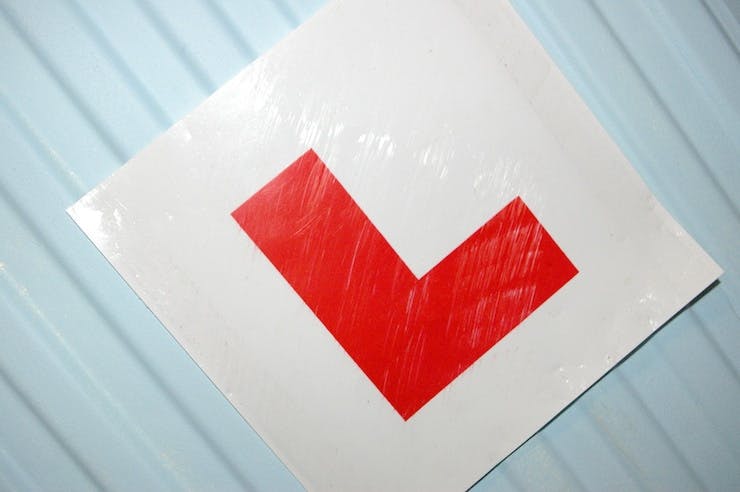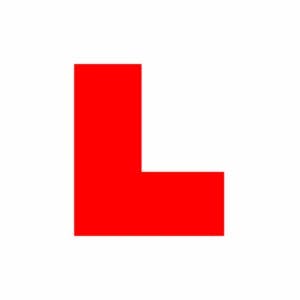
Learner drivers are always easily recognisable on the road thanks to the familiar red L plates adorning their vehicle. Meanwhile, new drivers often sport green P plates, proudly showing that they've passed their test.
However, while these signs are incredibly common, you may not know when you should (or shouldn't) be using them. That's why we've decided to put together this handy guide to all of the rules surrounding L and P plates.
L plates

As you have probably guessed, the L in L plate stands for learner. That's because learner drivers must display an L plate on their vehicle at all times. You can receive up to six points (and/or a fine) on your licence for failing to do so, so it's incredibly important to make sure they're on!
How many L plates do you need on a car?
Your L plates should be easily visible to other road users on both the front and rear of your vehicle. As such, if you're a learner, your car should have two L plates at all times.
Where to put L plates
There are no specific rules on placement of L plates. They simply must be in an obvious position—though you should avoid placing them on your front or rear windscreen, as this may block your view. So far, it's all been simple enough. However, some of the rules surrounding L plates are stricter...
Specifications
It may surprise you, but there are actually very precise rules governing the size and dimensions of an L plate.
The plate itself must be a 178x178 mm square. Meanwhile, the L itself must be 102 mm tall and 89 mm wide. There are even regulations covering the width of the base and ascender of the L, and its position in the centre of the square.
All of this may (understandably) seem very pedantic. However, it's important to remember that these rules help to make L plates easily visible and recognisable to other drivers. If you're not complying with the rules, then the penalty is the same as not displaying an L plate at all: up to six points on your licence. You may also receive a fine, which typically comes to around £100. We're sure you'll agree that there are plenty of better ways to use your money!
If you buy an L plate from any shop or online retailer, then you should be able to rest assured that they meet the criteria. You can also print your own L plate, provided that it follows the rules.
Tip: After a few weeks of use, your L plate may be showing some signs of wear and tear. You might be tempted to trim the edges to neaten it up—but don't. This could make it too small! It is okay, however, to round off the corners of the background of your L plate.
Who needs an L plate?
Quite simply, L plates are mandatory for all learner drivers. As a learner, your car must have two L plates on whenever you're driving. They must not be defaced, and must not fall off your car mid-drive.
As such, drivers generally opt for either magnetic or adhesive L plates. If you're not a learner driver, then you should remove the L plates from your car. This also applies if you have a full UK licence, but share your car with a learner—if a fully licensed driver is behind the wheel, the L plate should be taken off! However, it's worth noting that you shouldn't get into any trouble for accidentally keeping on an L plate. Additionally, driving instructors are likely to keep their L plates on at all times—of course, this is perfectly legal!
D plates

If you live in England, Scotland or Northern Ireland, then this section won't apply to you. However, if you're on the roads in Wales, you may spot a few cars sporting D plates on the roads. To avoid any confusion, D plates are the same as L plates. The only difference is that they refer to the Welsh language term for learner, dysgwr. If you're driving in Wales, you're free to choose to display D plates, L plates, or both. However, these plates are only valid in Wales.
So, if you're likely to cross the border into England, make sure you have your L plates on! Of course, these aren't the only regional differences when it comes to driving in the UK.
Check out our guide to driving test pass rates by area—and find out which Home Nation comes out on top!
P plates
About P plates

When you've recently passed your driving test, it's common to display green P plates on your car. These help to signify that you're a new driver.
Interestingly, the P on a P plate doesn't stand for "pass", but instead for "probationary". Don't worry: this doesn't mean that there are restrictions on your driving ability. It simply lets other drivers know that you haven't had your licence for long.
Unlike L plates, which all learner drivers must display on their cars, P plates are not mandatory. This means that you have the choice whether to put them on or not.
Why use P plates?
As P plates aren't mandatory, you might be wondering why people choose to display them. However, there are definitely benefits to putting them on. Displaying a P plate is the only way to show other drivers that you don't have much experience. This is important as, since you'll have only recently passed your test, you may not have driven around much alone.
In fact, many learners even choose to take their instructor on their driving test. You may therefore need a bit more time to fully adjust to driving solo on a regular basis. Since a P plate lets other drivers know that you're fresh on the road, it also encourages them to give you a bit more leeway when it comes to making mistakes. With other drivers being somewhat more lenient, this, in turn, gives you time to become a more confident driver, and avoid becoming one of the many young road users caught up in car accidents.
As an added bonus, it also helps you to show off to your mates that you've just passed your test—which is never a bad thing!
Rules and regulations

Having discussed some very complex rules surrounding L plates above, you might expect a similar level of detail when it comes to P plates.
However, P plates are not legally mandatory—and, as such, there are fewer rules governing them. You have the choice whether to use them (or not), and how long you wish to keep it on your car. If you do wish to use P plates, then you should aim to follow the same guidance as L plates. This includes making sure that you clearly display your P plates on both the front and rear of your car. However, as there are no legal specifications for what a P plate should look like, you won't need to worry about incorrect sizes or dimensions.
In short, if you feel totally confident as a new driver, then you don't have to display P plates at all. However, if you'd like a bit more time to gain confidence, then feel free to put them on for as long as you wish!
What else should learners and new drivers look out for?
Of course, while there are some complicated rules around L and P plates, these are just the tip of the iceberg. There are plenty of other important things for learners and new drivers to take into consideration, too.
First, there are the rules surrounding learning to drive. For starters, you'll need to ensure you drive alongside a DVSA-registered driving instructor.
Alternatively, a friend or family member can accompany you, as long as they are over 21, qualified to drive the vehicle you're learning in, and have held a full UK driving licence for a minimum of three years. Additionally, you'll need to make sure you've got the correct learner driver insurance cover for the vehicle you're practising in. Once you've passed your test, you'll need young driver insurance. It's also worth keeping up to date with the latest news surrounding driving tests and tuition.
Subscribe for driving advice, offers & more
We'd love to let you know about our courses, news and offers via email. You may unsubscribe at any time.
Star Genie Limited trading as PassMeFast. Company number 10093359
Copyright © 2024 owned by Star Genie Limited
PassMeFast, Blue Tower, MediaCityUK, Salford, M50 2ST

